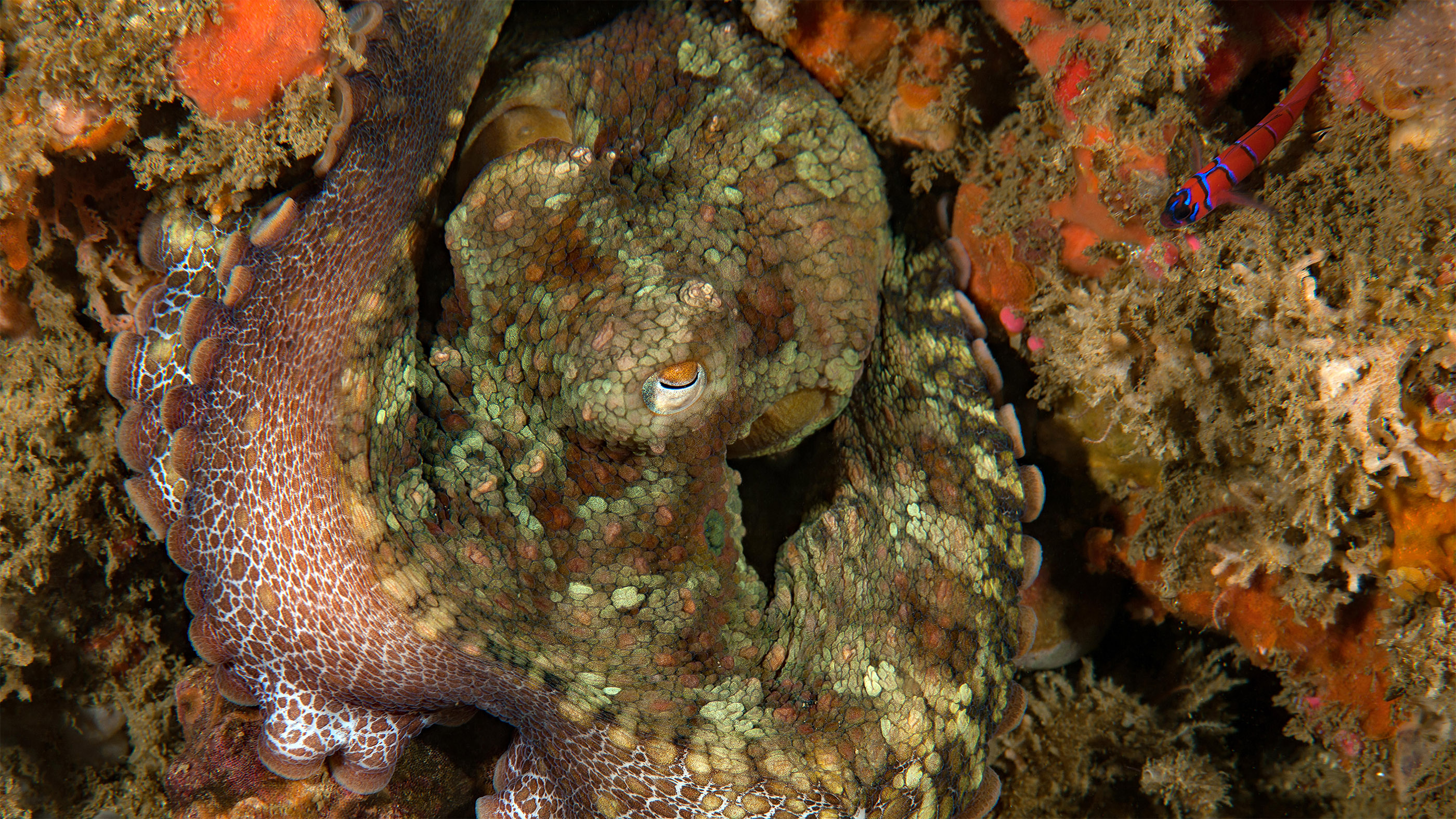Octopuses torture and eat themselves after mating. Science finally knows why.
She even eats pieces of her own arms.

Many animal species die after they reproduce. But in octopus mothers, this decline is particularly alarming: In most species, as an octopus mother's eggs get close to hatching, she stops eating. She then leaves her protective huddle over her brood and becomes bent on self-destruction. She might beat herself against a rock, tear at her own skin, even eat pieces of her own arms.
Now, researchers have discovered the chemicals that seem to control this fatal frenzy. After an octopus lays eggs, she undergoes changes in the production and use of cholesterol in her body, which in turn increases her production of steroid hormones — a biochemical shift that will doom her. Some of the changes may hint at processes that explain longevity in invertebrates more generally, said Z. Yan Wang, an assistant professor of psychology and biology at the University of Washington.
"Now that we have these pathways, we're really interested to link them to individual behaviors, or even individual differences in how animals express these behaviors," Wang told Live Science.
Programmed to die
Even as an English-major undergraduate student, Wang was intrigued by female reproduction, she said. When she transitioned into graduate school in science, she kept that interest, and was struck by the dramatic deaths of octopus mothers after they laid their eggs. No one knows the purpose of the behavior. Theories include the idea that the dramatic death displays draw predators away from eggs, or that the mother's body releases nutrients into the water that nurture the eggs. Most likely, Wang said, the die-off protects the babies from the older generation. Octopuses are cannibals, she said, and if older octopuses stuck around, they might end up eating all of each other's young.
Related: How do octopuses change color?
A 1977 study by Brandeis University psychologist Jerome Wodinsky found the mechanism behind this self-destruction lay in the optic glands, a set of glands near the octopus's eyes that is roughly equivalent to the pituitary gland in humans. If the nerves to the optic gland were cut, Wodinsky found, the mother octopus would abandon her eggs, start eating again and live for another four to six months. That's an impressive life extension for creatures that live only about a year.
But no one knew what the optic gland was doing to control this cascade of self-injury.
Get the world’s most fascinating discoveries delivered straight to your inbox.
"From the very beginning, I was really keen to do the experiments that we outlined in the paper we just published, which is essentially juicing the optic gland and then identifying the components of that juice," Wang said.
Wang and her colleagues analyzed the chemicals produced in the optic glands of California two-spot octopuses (Octopus bimaculoides) after they laid eggs. In 2018, a genetic analysis of the same species showed that after egg-laying, the genes in the optic glands that produce steroid hormones (which are built, in part, with cholesterol components) started going into overdrive. With that study as a guidepost, the scientists focused on the steroids and related chemicals produced by the optic glands in the two-spot octopuses.



Fatal changes
They found three separate chemical shifts that occurred around the time the octopus mother laid her eggs. The first was a rise in pregnenolone and progesterone, two hormones associated with reproduction in a host of creatures (in humans, progesterone rises during ovulation and during early pregnancy). The second shifts were more surprising. The octopus mothers began to produce higher levels of a building block of cholesterol called 7-dehydrocholesterol, or 7-DHC. Humans produce 7-DHC in the process of making cholesterol too, but they don't keep any in their systems for long; the compound is toxic. In fact, infants born with the genetic disorder Smith-Lemli-Opitz syndrome can't clear 7-DHC. The result is intellectual disability, behavioral problems including self-harm, and physical abnormalities like extra fingers and toes, and cleft palate.
Finally, the optic glands also began producing more components for bile acids, which are acids made by the liver in humans and other animals. Octopuses don't have the same kind of bile acids as mammals, but they do, apparently, make the building blocks for those bile acids.
"It suggests that it is a brand new class of signaling molecules in the octopus," Wang said.
The bile acid components are intriguing, Wang said, because a similar set of acids has been shown to control the life span of the worm Caenorhabditis elegans, which is commonly used in scientific research because of its simplicity. It may be that the bile acid components are important for controlling longevity across invertebrate species, Wang said.
Octopuses are hard to study in captivity because they require a lot of space and perfect conditions for them to grow to sexual maturity and breed. Wang and other octopus researchers have now worked out a way to keep the lesser Pacific striped octopus (Octopus chierchiae) alive and breeding in the lab. Unlike most other octopus species, Pacific striped octopuses can mate multiple times and brood multiple clutches of eggs. They don't self-destruct as their eggs get ready to hatch, making them perfect specimens for studying the origin of the morbid behavior.
"I'm really, really excited to study the dynamics of the optic gland in that species," Wang said.
The researchers published their findings May 12 in the journal Current Biology.
Originally published on Live Science.

Stephanie Pappas is a contributing writer for Live Science, covering topics ranging from geoscience to archaeology to the human brain and behavior. She was previously a senior writer for Live Science but is now a freelancer based in Denver, Colorado, and regularly contributes to Scientific American and The Monitor, the monthly magazine of the American Psychological Association. Stephanie received a bachelor's degree in psychology from the University of South Carolina and a graduate certificate in science communication from the University of California, Santa Cruz.


